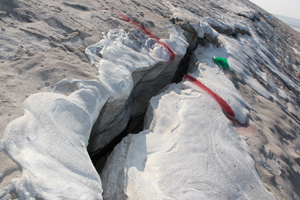In filing a motion on May 16 for a new trial against HDR Engineering over cracks at its Lithia, Fla., reservoir, Tampa Bay Water attorneys asserted judicial errors involving the exclusion of evidence and the failure to allow a jury site visit of the facility.

In a May 17 memo to the utility’s board of directors, Tampa Bay Water general counsel Barrie S. Buenaventura stated: “We believe Tampa Bay Water should be granted a new trial because the jury’s verdict is against the clear weight of evidence presented at trial and because the Court erroneously excluded evidence that the jury should have been allowed to consider.”
Richard Harrison, who served as Tampa Bay Water’s lead attorney at trial, filed the motion with the U.S. District Court in Tampa, where the case was originally heard. The motion maintains that there were “numerous errors in the exclusion and admission of evidence.” Some of the arguments for a new trial included in TBW’s motion include:
• Judge James Whittemore improperly excluded evidence related to HDR’s inspections of the embankment’s construction. Tampa Bay Water states that this evidence would have enabled it to rebut HDR’s theory that the embankment was built too thickly.
• TBW states it was prevented from asking a utility employee during redirect testimony what she meant when she said the protective layer had been placed “quite thick.”
• The judge erred when he excluded from evidence a 2008 memo from an HDR executive that expressed concerns over the potential business impact of the engineer’s design being found to blame for the cracks at the reservoir. (Harrison addressed the memo at trial during his questioning of TBW general manager Gerald Seeber and mentioned it as part of his closing arguments.)
• The court improperly prevented two Tampa Bay Water witnesses from testifying during the trial’s rebuttal stage.
• The utility’s lawyers argue that an HDR witness was improperly allowed to use a photograph during his testimony that was never entered into evidence. They also cite other related photos that were “untimely disclosed.”
Tampa Bay Water’s motion also asserts that Judge Whittemore’s denial of a request for a “jury view” of the reservoir resulted in an exclusion of evidence.
According to the motion, TBW attorneys had sought a visit of the reservoir “many months” prior to trial, but were rejected. During the trial, one of the jurors sent a question to Judge Whittemore asking if a visit to the reservoir should be in order. After considering the juror’s request, the judge again nixed a trip to the Lithia facility, citing his concern for juror safety as one factor in his decision.
On this matter, the utility’s motion states: “TBW appreciates that the jury view is a matter within the Court’s sound discretion. But if there were ever a case in which the refusal to permit a jury view were an abuse of that discretion, this is the case. No case more compellingly demonstrates that ‘If a picture is worth a thousand words, then the real thing is worth a thousand pictures.’”
Additionally, Harrison argues, “Why should the jurors, who are tasked with resolving the complex and disputed factual issues in this case, be the only people who are not permitted to see the reservoir?”
Finally, the motion states the judge erred by allowing HDR to offer testimony and evidence of its own theory of the cause of the cracking.
After a month-long trial in Tampa, a federal jury ruled on April 10 in favor of HDR, and found the engineer had no liability for damages related to the cracking at the reservoir. At trial, Tampa Bay Water had asked for $73.25 million in damages, dating back to 2005. HDR has estimated that with the accrual of interest, that figure would have ballooned to more than $140 million.
According to Buenaventura’s memo to the TBW board, HDR’s response to the utility’s motion for a new trial is due to the court by June 4.






















Post a comment to this article
Report Abusive Comment